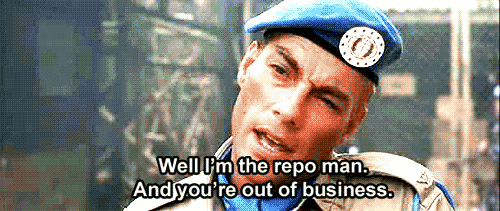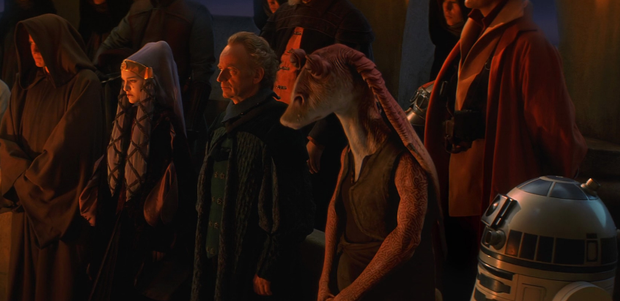Exploiting our Archives: Control Nathan Rabin 4.0 #55 Street Fighter (1994)
Welcome, friends, to the latest entry in Control Nathan Rabin 4.0. It’s the column where I give y’all the opportunity to pick out a film I must watch and then write about in exchange for a one-time, one hundred dollar pledge to the site’s Patreon account. The price goes down to 75 dollars for each subsequent choice and we’re running a Father’s Day special where you can choose a movie for the dad in your life for a mere fifty dollars if you pledge before June 16th..
Or you can choose a movie for ALL of the friends you grew up with who became fathers, as repeat Control Nathan Rabin 4.0 patron and Society for the Toleration of Nathan Rabin member in good standing Taylor Shann chose to do with the 1994 motion picture Street Fighter. It’s a terrible, terrible movie I couldn’t wait to revisit because it hit me right in the nostalgia sweet spot. I’m not much of a video game fan, I have to admit.
Yes, I was a central figure in GamerGate, on both sides, switching allegiances daily, but that was all about ethics in video game journalism, something I think we can all agree should be society’s foremost consideration. Because a society without an ethical video game press is no kind of society at all. And a free press without sufficiently ethical video game journalism is nothing less than the enemy of the people.
But Street Fighter and its sequel: that was my shit. When I was a rage-choked latchkey kid living on Mountain Dew, Cheeto’s and rage on the north side of Chicago in the late 1980s and early 1990s I would head on down to the corner store, the bodega, to play Street Fighter and Double Dragon and lesser games alongside all the other juvenile delinquents.
Looking good!
I loved Street Fighter as an arcade game. It was elegant in its simplicity, a fighting game with unforgettable, larger than life characters doing battle in various exotic international locales and clean, easy to understand gameplay.
To me, Street Fighter and Street Fighter II were the kings of the fighting games, their only real competition being the more graphic and gruesome rival Mortal Kombat, with its ghoulish “Fatalities” and gleeful ultra-violence.
It’s been over three decades since Street Fighter occupied an obsessive place at the center of my life, but I remember enough about the vivid, multi-dimensional worlds of the game to recognize that Street Fighter the movie looks and feels almost nothing like the ubiquitous, incredibly popular pop culture phenomenon of a game that inspired it.
Oh sure, the characters are largely the same, wearing mediocre cosplay-level renditions of the iconic costumes worn in the beloved video game series, but everything feels decidedly off-brand and tone-deaf, beginning with marquee star Jean-Claude Van Damme, Muscles from Brussels himself, playing William Guile, an Air Force Major who loves the red, white and blue, and his homeland the United States so much that he’s got Old Glory tatted on his shoulder.
Get a load of that muscle! #Impressed
Of all of the big European action stars (Schwarzenegger, Van Damme, Lundgren), Van Damme, who received eight million dollars for his role here, is far and away the most European. He’s Belgian down to his DNA. Van Damme is so European that the American flag tattoo he sports here can’t help but feel deliciously ironic, even sarcastic, as if to say, “Could you even imagine if I, Jean-Claude Van Damme, was American?”
Van Damme was at the height and depth of his cocaine addiction when he made Street Fighter and it shows in his waxen, one note turn as a man single-mindedly obsessed with bringing international warlord General Bison (Raul Julia) to justice at any cost, even when that means flagrantly disobeying the commands of his superiors at the A.N, a U.N-like international peace-keeping organization, when he finds them unacceptably wussy.
If Van Damme is on auto-pilot, Julia is almost too committed to his character’s outsized villainy. Julia makes a gourmet five course meal out of the crumbs the screenplay leaves him, portraying the power-mad warlord and would-be world-conqueror as if he was one of Shakespeare’s lost kings, albeit one who spoke almost entirely in comic book hyperbole, with row upon row of exclamation points after every artfully shouted declaration and crazed monologue.
There is a level of arch-theatricality that can only be accomplished through the presence and intense, purposeful usage of a cape. Let’s just say that as one of the staples of Bison’s uniquely satisfying, Bond villain-at-the-disco costume is a giant red cape that the legendary actor uses to great effect.
Julia is the one element of the film’s muddled vision that over rather than under-delivers. It helps that Street Fighter writer-director Steve De Souza, who co-wrote one of the all-time great action movie screenplays in Die Hard and one of the all-time worst action movies in this train wreck, gives Julia’s the most exquisitely pulpy, purple dialogue, like when a power-mad Bison, having acquired super-powers like flight and the ability to shoot electricity out of his hands screams to the very heavens as well as Van Damme’s Guile, “What's the matter? You come to fight a madman, and instead find a GOD? Do you still refuse to accept my godhood? Keep your God! In fact, now may be a good time to pray to Him! For I beheld Satan as he came down from Heaven like LIGHTING!!!”
It seems safe to assume that at no point in filming did De Souza gently implore Julia, “Hey, you mind reining it in a little in that next take? That was a little broad.”
Bison kicks off the action by demanding twenty billion dollars for the release of prisoners of relief workers for the A.N, the film’s U.N surrogate. Bison is a man of simple desires. He wants twenty BILLION dollars or the prisoners DIE. He wants to take over the world. He wants to best Guile in hand to hand physical combat, to prove that he is the ultimate warrior and he wants to harness the powers of mad science to create the ultimate super-soldier in the form of Carlos “Charlie” Blanka (Robert Mammone).
The film’s treatment of Blanka epitomizes its “If it ain’t broke, go ahead and break it” approach its source material. In the video games, Blanka was a legit badass, a hulking, green skinned mutant monster with claws and a crazy shock of orange hair. In Street Fighter, however, he’s a soldier who is genetically altered and conditioned to be a monstrous brute via exposure to violent stimuli until he looks like an off-brand children’s party entertainer version of the Incredible Hulk or a struggling actor auditioning to play a Chaka-like Neanderthal in a low-budget knockoff of Land of the Lost who decided to wear his own make-up to the audition.
Street Fighter tries to play up Blanka’s character’s internal struggle between good and evil. They try to turn him into Frankenstein’s Monster, a violent beast with a heart and soul. In this respect, it fails. It fails on every other level as well. This is the worst, cheapest, most ill-conceived version of the character imaginable.
That’s true of the man who makes Blanka a monster as well. In video games, Dhalsim is a loose-limbed Yoga master with the balletic, sinister grace of a panther whose body and endlessly extendable limbs defies man’s laws, God’s laws and the laws of gravity. Here, he’s a kidnapped scientist filled with guilt about the off-brand Incredible Hulk Julia’s big baddie forces him to create in defiance of God’s will in the form of Blanca. It’s not an improvement. It never is.
#NailedIt!
Part of what makes Street Fighter so frustrating is that Van Damme made a much more satisfying Street Fighter movie, albeit of the unofficial, makeshift variety, in the form of 1988’s Bloodsport, one of President Trump’s all-time favorite movies (seriously) and the movie that made launched its limber lead to stardom. Bloodsport took the form of a tournament that provided the perfect framework for one-on-one fighting between larger than life grapplers.
In its iconic video game form, Street Fighter was nothing but one-on-one battles. Its feature film adaptation seems to be challenging itself to feature as few crowd-pleasing fights as humanly possible, to toss out everything that people loved and recognized about the video game in favor of a half-assed James Bond knockoff filmed on what appear to be styrofoam sets and filled with some of the worst one-liners and quips this side of Batman & Robin, which it resembles in far too many ways.
De Souza is a brilliant and accomplished screenwriter but his vision for Street Fighter seemed to be that video games are stupid and silly and for babies, so a faithful feature film adaptation should follow suit. Instead of letting the street fighters in Street Fighters be, you know, street fighters battling in the streets in one on one altercations the film creates dizzyingly stupid new contexts for them to be together. In Street Fighter E. Honda is a professional sumo wrestler and Balrog is a towering boxer based on Mike Tyson. In the movie, they’re perplexingly both members of journalist Chun-Li’s technical crew as well as a sumo wrestler and boxer with personal grudges against Bison for hurting their fighting careers.
Oh sure, Street Fighter briefly features underground fighting but it’s much more focussed on Guile and the A.N’s amphibious assault on Shadaloo, the Southeast Asian nation Bison rules with an iron fist and Chun-Li and her suspiciously fighting-adept camera crew taking on Bison and his comic relief sidekicks Zangief (Andrew Bryniarski) and DeeJay (Miguel Nunez Jr. of Juwanna Mann fame).
Street Fighter resembles its ostensible inspiration so infrequently that when a fighter strikes a familiar pose or executes a trademark move it feels like an Easter egg for the super-fans, an inside joke instead of representing the essence of the wildly popular, iconic video game.
The great promise of the Street Fighter movie is that eventually, climactically, its main hero will square off against its outsized, power-mad villain in one-on-one combat, that our marquee hero will vanquish the big baddie.
In actuality, that means that Jean-Claude Van Damme, the very image of physical perfection even during his Coke-fueled nightmare years and a genuine martial artist fighting a distractingly gaunt, 54 year old Broadway actor on the very brink of death.
Guile kicks his rival into a bank of computers, electrocuting him. Then Bison roars back to life as a electromagnetic powered man-god capable of flying and shooting electricity. And it still seems like a terribly unfair fight with Guile holding all the advantages. Street Fighter is never better, or crazier, than during a climax that finds a wild-eyed Julia over-acting with an epic fury that comes close to justifying this whole ridiculous endeavor, this camp calamity, this insult to a pretty damn good video game series.
Yes, it was Captain Cocaine versus one of our greatest actors at his most gleefully unhinged. Van Damme might have won the skirmish, unsurprisingly and inevitably but Julia triumphed creatively. Like Frank Langella’s similarly transcendent, similarly huge performance as Skeletor in Masters of the Universe movie, Julia here illustrates unforgettably how a great actor can single-handle elevate even the most misguided boondoggle.
Help ensure a future for the Happy Place by pledging at https://www.patreon.com/nathanrabinshappyplace
Finally, Help ensure a future for The Happy Place by pledging at https://www.patreon.com/nathanrabinshappyplace you CAN and SHOULD pick up the Happy Place’s very first book, The Weird Accordion to Al, a lovingly illustrated deep dive into the complete discography of “Weird Al” Yankovic, with an introduction from Al himself here or here








